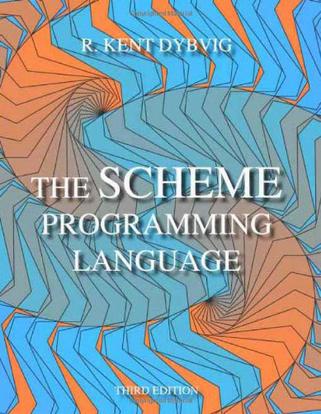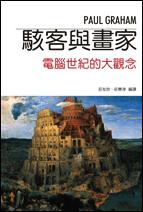-

The Scheme Programming Language
This thoroughly updated edition of The Scheme Programming Language provides an introduction to Scheme and a definitive reference for standard Scheme, presented in a clear and concise manner. Written for professionals and students with some prior programming experience, it begins by leading the programmer gently through the basics of Scheme and continues with an introduction to some of the more advanced features of the language. Many exercises are presented to help reinforce the lessons learned, and answers to the exercises are given in a new appendix. Most of the remaining chapters are dedicated to the reference material, which describes in detail the standard features of Scheme included in the Revised Report on Scheme and the ANSI/IEEE standard for Scheme. Numerous examples are presented throughout the introductory and reference portions of the text, and a unique set of extended example programs and applications, with additional exercises, are presented in the final chapter. Reinforcing the book's utility as a reference text are appendixes that present the formal syntax of Scheme, a summary of standard forms and procedures, and a bibliography of Scheme resources. The Scheme Programming Language stands alone as an introduction to and essential reference for Scheme programmers. It is also useful as a supplementary text for any course that uses Scheme. The Scheme Programming Language is illustrated by artist Jean-Pierre Hebert, who writes Scheme programs to extend his ability to create sophisticated works of digital art. -

LISP语言
本书共十四章。一至三章介绍lisp的基本语法、语义、s表达式的概念、以及lisp的核心部分lisp1;四至十章主要讨论lisp的函数程序设计方法;十一至十三章是lisp的非函数程序设计部分;十四章介绍lisp中的一些高级成分和高级应用。 本书以lisp语言为素材,注重训练学生的函数式程序设计能力。书中用形式化的方法来表述lisp的语义,旨在提高学生的理论素养,同时,书中有大量的习题和例题,涉及到lisp的基本概念直至人工智能领域中的高级应用。仔细阅读这些程序并认真作习题,对学好本课程是十分有益的。 本书可用作高等院校计算机专业的教材或参考书,也可供从事人工智能工作的研究人员、工程技术人员参考。 -

駭客與畫家
本書檢視駭客的世界,以及駭客活動背後的動機。在這個日漸電腦化的世界裡,駭客是個帶有多重意義的名詞,它對創意使用者帶來尊崇,也對規矩破壞者帶來鄙視意味。Paul Graham 的散文引領讀者瀏覽他筆下的駭客世界,一個聰明才智泛流的新荒野。 為什麼一個唸不完高中的孩子,最後卻晉身為世上最有權勢的人?科技是否將建立出新的鴻溝,一端是懂得使用科技的人,一端是不會使用的人?微軟是否將接掌網際網路?我們該拿垃圾郵件怎麼辦?這些都是本書討論的議題。 如果你想瞭解駭客心理在想什麼,這本書可以回答你的問題。如果你已經是個駭客,或許,你能從這本散文集中發現自己的身影。 -

Common Lisp
This book is about learning to program in Lisp. Although widely known as the principal language of artificial intelligence research—one of the most advanced areas of computer science—Lisp is an excellent language for beginners. It is increasingly the language of choice in introductory programming courses due to its friendly, interactive environment, rich data structures, and powerful software tools that even a novice can master in short order. When I wrote the book I had three types of reader in mind. I would like to address each in turn. · Students taking their first programming course. The student could be from any discipline, from computer science to the humanities. For you, let me stress the word gentle in the title. I assume no prior mathematical background beyond arithmetic. Even if you don’t like math, you may find you enjoy computer programming. I’ve avoided technical jargon, and there are lots of examples. Also you will find plenty of exercises interspersed with the text, and the answers to all of them are included in Appendix C. · Psychologists, linguists, computer scientists, and other persons interested in Artificial Intelligence. As you begin your inquiry into AI, you will see that almost all research in this field is carried out in Lisp. Most Lisp texts are written exclusively for computer science majors, but I have gone to great effort to make this book accessible to everyone. It can be your doorway to the technical literature of AI, as well as a quick introduction to its central tool. · Computer hobbyists. Prior to about 1984, the Lisps available on personal computers weren’t very good due to the small memories of the early machines. Today’s personal computers often come with several megabytes of RAM and a hard disk as standard equipment. They run full implementations of the Common Lisp standard, and provide the same high-quality tools as the Lisps in university and industrial research labs. The ‘‘Lisp Toolkit’’ sections of this book will introduce you to the advanced features of the Common Lisp programming environment that have made the language such a productive tool for rapid prototyping and AI programming. This current volume of the ‘‘gentle introduction’’ uses Common Lisp throughout. Lisp has been changing continuously since its invention 30 years ago. In the past, not only were the Lisp dialects on different machines incompatible, but programs written in one dialect would often no longer run in that same dialect a few years later, because the language had evolved out from under them. Rapid, unconstrained evolution was beneficial in the early days, but demand for a standard eventually grew, so Common Lisp was created. At present, Common Lisp is the de facto standard supported by all major computer manufacturers. It is currently undergoing refinement into an official standard. But Lisp will continue to evolve nonetheless, and the standard will be updated periodically to reflect new contributions people have made to the language. Perhaps one of those contributors will be you. -

Common Lisp
This book is about learning to program in Lisp. Although widely known as the principal language of artificial intelligence research—one of the most advanced areas of computer science—Lisp is an excellent language for beginners. It is increasingly the language of choice in introductory programming courses due to its friendly, interactive environment, rich data structures, and powerful software tools that even a novice can master in short order. When I wrote the book I had three types of reader in mind. I would like to address each in turn. · Students taking their first programming course. The student could be from any discipline, from computer science to the humanities. For you, let me stress the word gentle in the title. I assume no prior mathematical background beyond arithmetic. Even if you don’t like math, you may find you enjoy computer programming. I’ve avoided technical jargon, and there are lots of examples. Also you will find plenty of exercises interspersed with the text, and the answers to all of them are included in Appendix C. · Psychologists, linguists, computer scientists, and other persons interested in Artificial Intelligence. As you begin your inquiry into AI, you will see that almost all research in this field is carried out in Lisp. Most Lisp texts are written exclusively for computer science majors, but I have gone to great effort to make this book accessible to everyone. It can be your doorway to the technical literature of AI, as well as a quick introduction to its central tool. · Computer hobbyists. Prior to about 1984, the Lisps available on personal computers weren’t very good due to the small memories of the early machines. Today’s personal computers often come with several megabytes of RAM and a hard disk as standard equipment. They run full implementations of the Common Lisp standard, and provide the same high-quality tools as the Lisps in university and industrial research labs. The ‘‘Lisp Toolkit’’ sections of this book will introduce you to the advanced features of the Common Lisp programming environment that have made the language such a productive tool for rapid prototyping and AI programming. This current volume of the ‘‘gentle introduction’’ uses Common Lisp throughout. Lisp has been changing continuously since its invention 30 years ago. In the past, not only were the Lisp dialects on different machines incompatible, but programs written in one dialect would often no longer run in that same dialect a few years later, because the language had evolved out from under them. Rapid, unconstrained evolution was beneficial in the early days, but demand for a standard eventually grew, so Common Lisp was created. At present, Common Lisp is the de facto standard supported by all major computer manufacturers. It is currently undergoing refinement into an official standard. But Lisp will continue to evolve nonetheless, and the standard will be updated periodically to reflect new contributions people have made to the language. Perhaps one of those contributors will be you. -

程序设计方法(中文版)
《程序设计方法》以Scheme语言为基础介绍计算和程序设计的一般理论和实践。《程序设计方法》由8个部分和7个独立的章节(第8、13、18、24、29、33、38章)组成。8个部分主要讨论程序设计,独立章节则介绍一些与程序设计和计算相关的话题。《程序设计方法》第1至第3部分介绍了基于数据驱动的程序设计基础。第4部分介绍了程序设计中的抽象问题。第5部分和第6部分是与递归及累积相关的内容。《程序设计方法》的最后两部分说明了设计程序的意义,阐述了如何应用前6个部分所描述的程序设计诀窍,以及使用赋值语句必须特别小心的一些问题。 《程序设计方法》可作为高等院校计算机科学与技术专业“程序设计导论”和“计算导论”的教材和教学参考书,也可作为函数式语言和Scheme语言的入门教材。